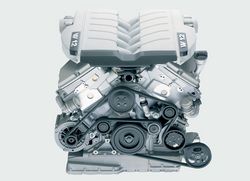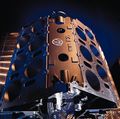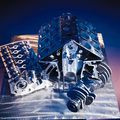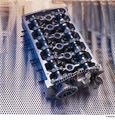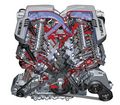.
W12 engine: Difference between revisions
No edit summary |
Red marquis (talk | contribs) m (→Images) |
||
| (5 intermediate revisions by 2 users not shown) | |||
| Line 1: | Line 1: | ||
The 6.0-liter W12 is a compact engine arrangement used in the [[Volkswagen]] / [[Audi]] AG vehicles, [[Audi A8|A8]], [[Volkswagen Phaeton|Phaeton]], and [[Bentley Continental GT|Continental GT]] and GTC. The "double-vee" arrangement allows for a small overall size in comparison with a tradition V- or Flat 12 engine. This engine made its debut in | [[Image:W12_Engine_front.jpg|thumb|right|250px|Volkswagen AG W12 Engine]] | ||
The 6.0-liter W12 is a compact engine arrangement used in the [[Volkswagen]] / [[Audi]] AG vehicles, [[Audi A8|A8]], [[Volkswagen Phaeton|Phaeton]], and [[Bentley Continental GT|Continental GT]] and GTC. The "double-vee" arrangement allows for a small overall size in comparison with a tradition V- or Flat 12 engine. This engine made its debut in 1997 [[Volkswagen]] W12 Nardo concept supercar at the Tokyo Motor Show. The arrangement is also used in the 4.0-liter [[W8]] used in the 2004-2006 [[Volkswagen Passat]] and the 8.0-liter [[W16]] of the [[Bugatti]] [[Bugatti Veyron|Veyron]] 16.4. | |||
== Technical == | == Technical == | ||
The Nardo version of the W12 was 5.6-liters in displacement with a length of only 20.1 inches, and a width of 27.6 inches. It produced a claimed 420 hp @ 5800 RPM and 390 lb-ft of torque @ 3000 RPM. | |||
<br><br> | |||
The Volkswagen Phaeton W12 uses a detuned version of the A8 engine producing 444 hp @ 6000 RPM and 406 lb-ft of torque at 3250 RPM. The compression ratio is also lower at 10.5 : 1. | |||
<br><br> | |||
The Bentley Continental Flying Spur, Continental GT and Continental GTC all use a twin-turbocharged version producing 552 hp (560PS/411kW) @ 6100 RPM and 479 lb ft (650Nm) of torque @ 1600 RPM. The compression ratio of this version is 9.0 : 1. | |||
<br><br> | |||
The full specifications for the Audi A8L W12 are courtesy of [http://www.audiworld.com/model/ the Audi Technical Specifications] | |||
<table border=1 tablecolor=#000000 bordercolor=#000008> | <table border=1 tablecolor=#000000 bordercolor=#000008> | ||
<tr bgcolor=#cccccc> | <tr bgcolor=#cccccc> | ||
| Line 67: | Line 18: | ||
</td> | </td> | ||
</tr> | </tr> | ||
<tr bgcolor=#ffffcc> | <tr bgcolor=#ffffcc> | ||
<td> | <td> | ||
| Line 72: | Line 24: | ||
</td> | </td> | ||
<td> | <td> | ||
DOHC aluminum | DOHC aluminum allow 15-degree V-angle, 72-degree bank angle W12 | ||
</td> | </td> | ||
</tr> | </tr> | ||
<tr bgcolor=#ffffcc> | <tr bgcolor=#ffffcc> | ||
<td> | <td> | ||
Displacment | |||
</td> | </td> | ||
<td> | <td> | ||
| Line 110: | Line 57: | ||
<td> | <td> | ||
11.0 : 1 | 11.0 : 1 | ||
</td> | </td> | ||
</tr> | </tr> | ||
<tr bgcolor=#ffffcc> | <tr bgcolor=#ffffcc> | ||
<td> | <td> | ||
Fuel Requirement | |||
</td> | </td> | ||
<td> | <td> | ||
Premium unleaded 91 AKI / 95 RON | |||
</td> | </td> | ||
</tr> | </tr> | ||
<tr bgcolor=#ffffcc> | <tr bgcolor=#ffffcc> | ||
<td> | <td> | ||
Horsepower (SAE) | |||
</td> | </td> | ||
<td> | <td> | ||
450 @ 6200 RPM | |||
</td> | </td> | ||
</tr> | </tr> | ||
<tr bgcolor=#ffffcc> | <tr bgcolor=#ffffcc> | ||
<td> | <td> | ||
Torque (lb-ft) | |||
</td> | </td> | ||
<td> | <td> | ||
428 @ 4000-4700 RPM | |||
</td> | </td> | ||
</tr> | </tr> | ||
<tr bgcolor=#66ccff> | <tr bgcolor=#66ccff> | ||
<td colspan=2> | <td colspan=2> | ||
Engine Design | |||
</td> | </td> | ||
</tr> | </tr> | ||
<tr bgcolor=#ffffcc> | <tr bgcolor=#ffffcc> | ||
<td> | <td> | ||
Cylinder Block | |||
</td> | </td> | ||
<td> | <td> | ||
Aluminum silicon alloy (Alusil) | |||
</td> | </td> | ||
</tr> | </tr> | ||
<tr bgcolor=#ffffcc> | <tr bgcolor=#ffffcc> | ||
<td> | <td> | ||
Crankshaft | |||
</td> | </td> | ||
<td> | <td> | ||
Forged, heat treated steel, 7 bearings. Offset crankpins. 21.2 kg | |||
</td> | </td> | ||
</tr> | </tr> | ||
<tr bgcolor=#ffffcc> | <tr bgcolor=#ffffcc> | ||
<td> | <td> | ||
Cylinder Head | |||
</td> | </td> | ||
<td> | <td> | ||
Aluminum Alloy | |||
</td> | </td> | ||
</tr> | </tr> | ||
<tr bgcolor=#ffffcc> | <tr bgcolor=#ffffcc> | ||
<td> | <td> | ||
Valvetrain/Intake | |||
</td> | </td> | ||
<td> | <td> | ||
DOHC, double overhead camshafts driven by a single chain, low friction roller cam followers,<br> | |||
< | 2 inlet and 2 exhaust valves per cylinder. Infinitely variable timing control for camshafts<br> | ||
(52-degrees at inlet and 22-degrees at exhaust valves) | |||
< | |||
</td> | </td> | ||
</tr> | </tr> | ||
<tr bgcolor=#ffffcc> | <tr bgcolor=#ffffcc> | ||
<td> | <td> | ||
Firing Order | |||
</td> | </td> | ||
<td> | <td> | ||
1 - 12 - 5 - 8 - 3 -10 - 6 - 7 - 2 - 11 - 4 - 9 | |||
</td> | </td> | ||
</tr> | </tr> | ||
<tr bgcolor=#ffffcc> | <tr bgcolor=#ffffcc> | ||
<td> | <td> | ||
Cooling System | |||
</td> | </td> | ||
<td> | <td> | ||
Water-cooled, thermostatically controlled radiator fan. Water pump in cylinder block/crankcase <br> | |||
map-controlled electronically controlled continued coolant circulation pump, coolant thermostat, <br> | |||
< | hydraulic fan and electric fan, coolant circulation, and water cooled alternator. | ||
<br> | |||
</td> | </td> | ||
</tr> | </tr> | ||
<tr bgcolor=#ffffcc> | <tr bgcolor=#ffffcc> | ||
<td> | <td> | ||
Lubrication System | |||
</td> | </td> | ||
<td> | <td> | ||
gear pump, pressure lubrication, full flow through oil cooler | |||
</td> | </td> | ||
</tr> | </tr> | ||
<tr bgcolor=#ffffcc> | <tr bgcolor=#ffffcc> | ||
<td> | <td> | ||
Fuel Injection/<br> | |||
Ignition System | |||
</td> | </td> | ||
<td> | <td> | ||
Fully electronic engine management system utilizing Bosch Motronic ME7.1.1, sequential injection with <br> | |||
electronic throttle control, hot-film air-mass sensing, cylinder selective knock control via 4 sensors <br> | |||
and permanent lamda control. | |||
</td> | </td> | ||
</tr> | </tr> | ||
<tr bgcolor=#ffffcc> | <tr bgcolor=#ffffcc> | ||
<td> | <td> | ||
Emission System | |||
</td> | </td> | ||
<td> | <td> | ||
3 | Air gap insulated exhaust manifolds, 4 close-coupled 3-way ceramic catalytic converters, 8 oxygen sensors | ||
</td> | </td> | ||
</tr> | </tr> | ||
<tr bgcolor=#66ccff> | <tr bgcolor=#66ccff> | ||
<td colspan=2> | <td colspan=2> | ||
Capacities | |||
</td> | </td> | ||
</tr> | </tr> | ||
<tr bgcolor=#ffffcc> | <tr bgcolor=#ffffcc> | ||
<td> | <td> | ||
Engine Oil | |||
</td> | </td> | ||
<td> | <td> | ||
13 qt. (12.5 l) | |||
</td> | </td> | ||
</tr> | </tr> | ||
<tr bgcolor=#ffffcc> | <tr bgcolor=#ffffcc> | ||
<td> | <td> | ||
Cooling System | |||
</td> | </td> | ||
<td> | <td> | ||
19.972 qt. (18.9 l) | |||
</td> | </td> | ||
</tr> | </tr> | ||
</table> | </table> | ||
== Images == | |||
<gallery> | |||
Image:W12 block.jpg|The cast aluminum block clearly shows the four banks of cylinders. | |||
Image:W12 components.jpg | |||
Image:W12_cylinder_head.jpg|The complex chain driven camshafts. | |||
Image:W12cutaway.jpg | |||
</gallery> | |||
==See Also== | |||
{{Piston engine configurations}} | |||
[[Category:Engines]] | |||
Latest revision as of 11:43, 29 October 2008
The 6.0-liter W12 is a compact engine arrangement used in the Volkswagen / Audi AG vehicles, A8, Phaeton, and Continental GT and GTC. The "double-vee" arrangement allows for a small overall size in comparison with a tradition V- or Flat 12 engine. This engine made its debut in 1997 Volkswagen W12 Nardo concept supercar at the Tokyo Motor Show. The arrangement is also used in the 4.0-liter W8 used in the 2004-2006 Volkswagen Passat and the 8.0-liter W16 of the Bugatti Veyron 16.4.
Technical
The Nardo version of the W12 was 5.6-liters in displacement with a length of only 20.1 inches, and a width of 27.6 inches. It produced a claimed 420 hp @ 5800 RPM and 390 lb-ft of torque @ 3000 RPM.
The Volkswagen Phaeton W12 uses a detuned version of the A8 engine producing 444 hp @ 6000 RPM and 406 lb-ft of torque at 3250 RPM. The compression ratio is also lower at 10.5 : 1.
The Bentley Continental Flying Spur, Continental GT and Continental GTC all use a twin-turbocharged version producing 552 hp (560PS/411kW) @ 6100 RPM and 479 lb ft (650Nm) of torque @ 1600 RPM. The compression ratio of this version is 9.0 : 1.
The full specifications for the Audi A8L W12 are courtesy of the Audi Technical Specifications
|
A8L W12 |
|
|
Type |
DOHC aluminum allow 15-degree V-angle, 72-degree bank angle W12 |
|
Displacment |
6.0-Liters (366 cu. in.) |
|
Bore |
3.31 inches (84 mm) |
|
Stroke |
3.55 inches (90.2 mm) |
|
Compression Ratio |
11.0 : 1 |
|
Fuel Requirement |
Premium unleaded 91 AKI / 95 RON |
|
Horsepower (SAE) |
450 @ 6200 RPM |
|
Torque (lb-ft) |
428 @ 4000-4700 RPM |
|
Engine Design |
|
|
Cylinder Block |
Aluminum silicon alloy (Alusil) |
|
Crankshaft |
Forged, heat treated steel, 7 bearings. Offset crankpins. 21.2 kg |
|
Cylinder Head |
Aluminum Alloy |
|
Valvetrain/Intake |
DOHC, double overhead camshafts driven by a single chain, low friction roller cam followers, |
|
Firing Order |
1 - 12 - 5 - 8 - 3 -10 - 6 - 7 - 2 - 11 - 4 - 9 |
|
Cooling System |
Water-cooled, thermostatically controlled radiator fan. Water pump in cylinder block/crankcase |
|
Lubrication System |
gear pump, pressure lubrication, full flow through oil cooler |
|
Fuel Injection/ |
Fully electronic engine management system utilizing Bosch Motronic ME7.1.1, sequential injection with |
|
Emission System |
Air gap insulated exhaust manifolds, 4 close-coupled 3-way ceramic catalytic converters, 8 oxygen sensors |
|
Capacities |
|
|
Engine Oil |
13 qt. (12.5 l) |
|
Cooling System |
19.972 qt. (18.9 l) |
Images
See Also
| Piston engine configurations v • d • e | |
|---|---|
| Type | Bourke • Controlled combustion • Deltic •Orbital • Piston • Pistonless (Wankel) • Radial • Rotary • Single • Split cycle • Stelzer • Tschudi |
| Inline types | H · U · Square four · VR · Opposed · X |
| Stroke cycles | Two-stroke cycle • Four-stroke cycle • Six-stroke cycle |
| Straight | Single · 2 · 3 · 4 · 5 · 6 · 8 · 10 · 12 · 14 |
| Flat | 2 · 4 · 6 · 8 · 10 · 12 · 16 |
| V | 4 · 5 · 6 · 8 · 10 · 12 · 16 · 20 · 24 |
| W | 8 · 12 · 16 · 18 |
| Valves | Cylinder head porting • Corliss • Slide • Manifold • Multi • Piston • Poppet • Sleeve • Rotary valve • Variable valve timing • Camless |
| Mechanisms | Cam • Connecting rod • Crank • Crank substitute • Crankshaft • Scotch Yoke • Swashplate • Rhombic drive |
| Linkages | Evans • Peaucellier–Lipkin • Sector straight-line • Watt's (parallel) |
| Other | Hemi • Recuperator • Turbo-compounding |
